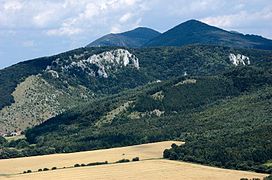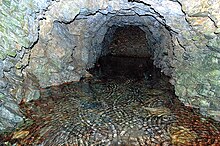Little Carpathians
| Little Carpathians | |
|---|---|
 Little Carpathians near Plavecké Podhradie | |
| Highest point | |
| Peak | Záruby |
| Elevation | 768 m (2,520 ft) |
| Geography | |
Lua error in Module:Location_map at line 526: Unable to find the specified location map definition: "Module:Location map/data/Malé Karpaty.png" does not exist.
| |
| Countries | Slovakia and Austria |
| Parent range | Western Carpathians |
The Little Carpathians (also: Lesser Carpathians, Slovak: Malé Karpaty; German: Kleine Karpaten; Hungarian: Kis-Kárpátok) are a low, about 100 km long, mountain range, part of the Carpathian Mountains. The mountains are situated in Western Slovakia, covering the area from Bratislava to Nové Mesto nad Váhom, and northeastern Austria, where a very small part called Hundsheimer Berge (or Hainburger Berge) is located south of the Devín Gate. The Little Carpathians are bordered by Záhorie Lowland in the west and the Danubian Lowland in the east.
In 1976, the Little Carpathians were declared a protected area under the name Little Carpathians Protected Landscape Area, covering 646.1 km². The area is rich in flora and fauna diversity and contains numerous castles, most notably the Bratislava Castle and caves, Driny being the only one open to the public. The three highest mountains are Záruby at Template:Unit height, Vysoká at Template:Unit height and Vápenná at Template:Unit height.
Description
Geomorphologically, the Little Carpathians belong into the Alps-Himalaya System, the Carpathian Mountains sub-system, its province Western Carpathians and its subprovince the Inner Western Carpathians.
Little Carpathians are further divided into four parts (from south to north):
- Devín Carpathians (Slovak: Devínske Karpaty) - in Bratislava and Austria
- Pezinok Carpathians (Slovak: Pezinské Karpaty) - from Bratislava to Buková
- Brezová Carpathians (Slovak: Brezovské Karpaty) - from Buková to Prašník
- Čachtice Carpathians (Slovak: Čachtické Karpaty) - from Prašník to Nové Mesto nad Váhom
The mountains are densely forested (90% being broad-leaved trees), the southeastern part contains extensive vineyards (e.g. Bratislava, Rača, Pezinok, Modra). Several castles or castle ruins are situated in the Little Carpathians, for example Devín Castle, Čachtice Castle, Červený Kameň Castle, and Smolenice Castle.
Geologically, the mountain range is part of the Tatra-Fatra Belt of core mountains There is together eight karst areas in the Little Carpathians: Devín Carpathians karst, Borinka (Pajštún) karst, Cajlan karst, Kuchyňa-orešany karst, Plavecký karst, Smolenice karst, Dobrovodský karst and Čachtice karst. The most important karst forms include caves Deravá, Tmavá skala, Driny, Čachtická cave and caves along the Borinský potok. Driny, a limestone cave, is the only cave open to public. Major streams include Vydrica and Suchý jarok.
Highest peaks
| Image | Slovak name | Height | Location & Notes |
|---|---|---|---|
 |
Záruby | 767.4 meters AMSL |
Above the village Smolenice |
 |
Vysoká | 754.3 meters AMSL |
Outside of the main ridge of the Little Carpathians, above the village Kuchyňa, summit offers extensive views |
 |
Vápenná (Roštún) | 752.2 meters AMSL |
Features a 4 meters tall concrete observation obelisk built in 2003 |
 |
Čertov kopec (vrch) | 751.8 meters AMSL |
Forested summit with no marked trails leading here |
 |
Veterlín | 723.5 meters AMSL |
|
 |
Havranica | 717.1 meters AMSL |
|
 |
Čelo | 716.0 meters AMSL |
Forested summit with no marked trails leading here |
 |
Veľká homoľa | 709.2 meters AMSL |
Since 2001, it features a 20 meters tall observation tower on the summit |
 |
Čmeľok | 709.0 meters AMSL |
Features a military radar on the summit |
 |
Skalnatá | 704.2 meters AMSL |
Offers extensive views |
History

While being a low mountain range, the Little Carpathians were always considered a mountain barrier due to being surrounded by various lowlands, often attaining a prominence of 500 meters. In the past, various types of ore were mined in the Little Carpathians used for the production of gold, silver, antimony, manganese and pyrite.
During Second World War, Little Carpathians were the birthplace of partisan group Janko Kráľ. Insurgency in the mountains lasted until the occupation by the Soviet Red Army in 1945.
Tourism
The Little Carpathians are a popular tourist destination in the Western Slovakia and the mountains are used for hiking, cycling, tramping, backpacking, automobile and motorcycle tourism, skiing, cross-country skiing and other winter sports. The mountain range contains a dense network of trails and the recreational infrastructure is relatively well developed, especially in the south. The Little Carpathians are popular as a destination place for the inhabitants of Bratislava and other larger cities in the region. Since the Middle Ages, the area is known for its wines and wine-making traditions. Well known centers of local wine-making include Svätý Jur, Modra and Pezinok.
Main tourist centers include the Slovak capital Bratislava, Pezinská Baba (halfway between Pezinok and Pernek) and Zochova chata (near Modra).
Images
-
Kršlenica rocks
-
Sandstone rock Sandberg
-
Hlboča waterfall
-
Cave Piesková
-
Cave Kabele
-
Speleothems in the cave PP1






